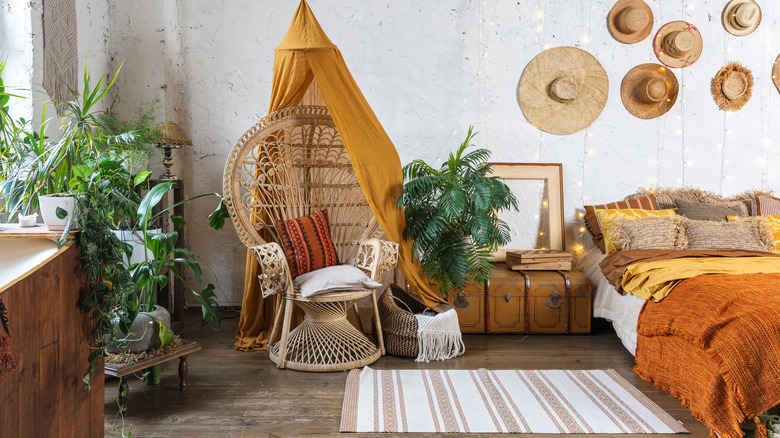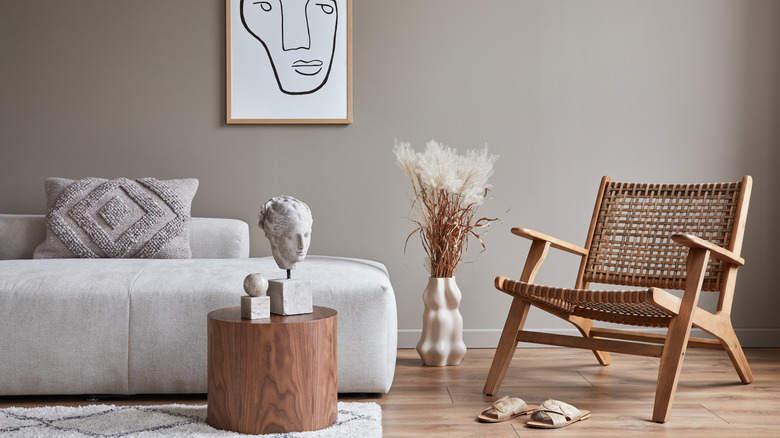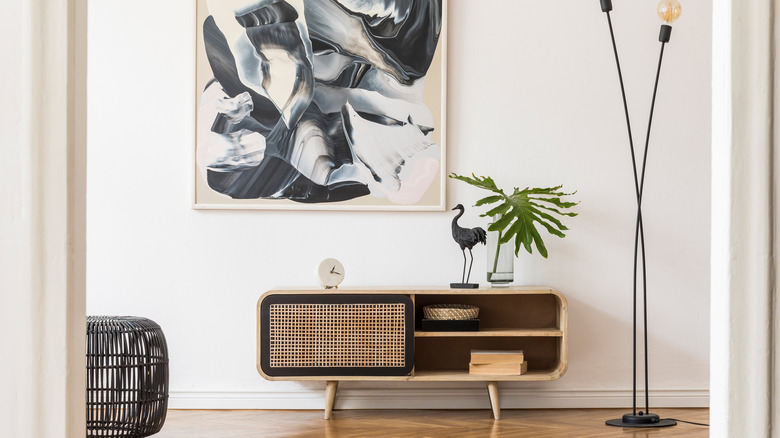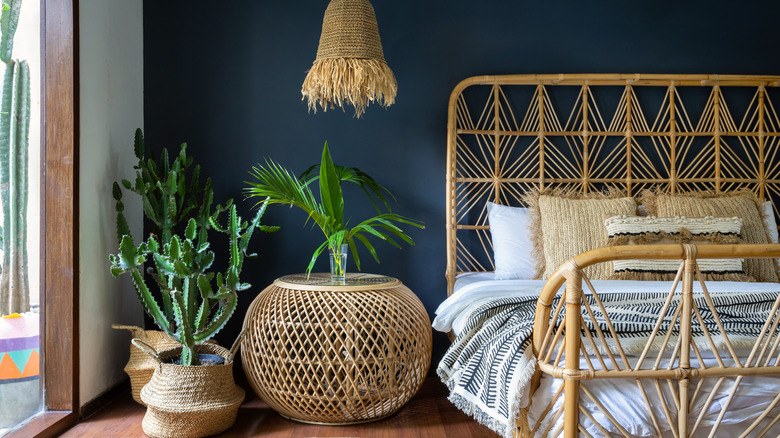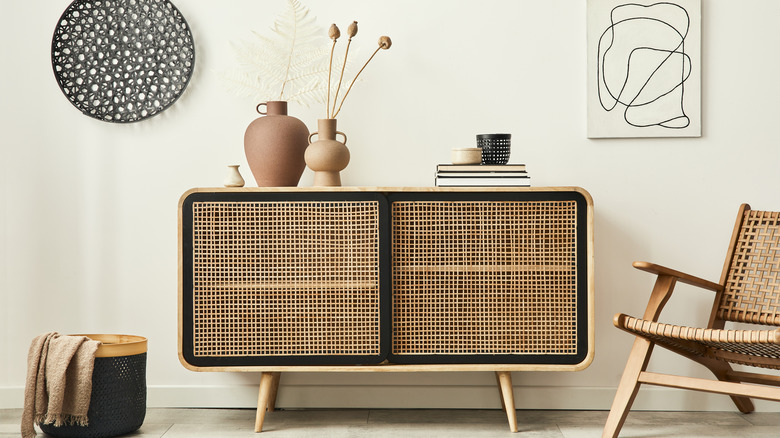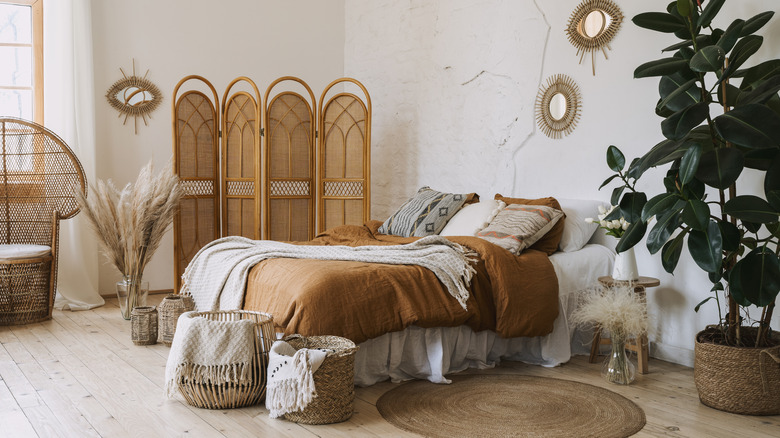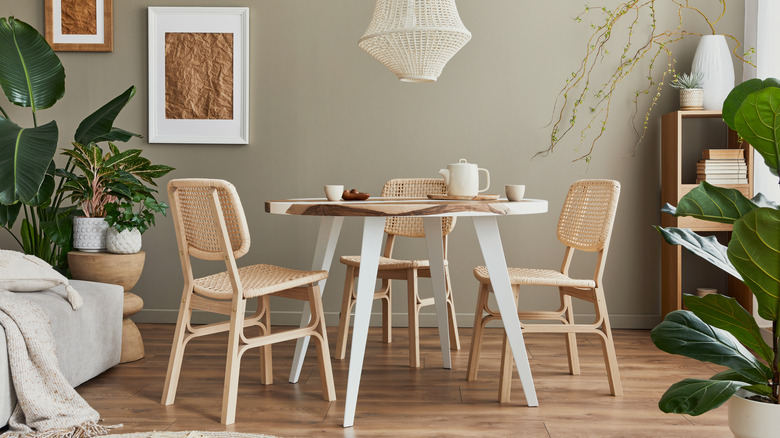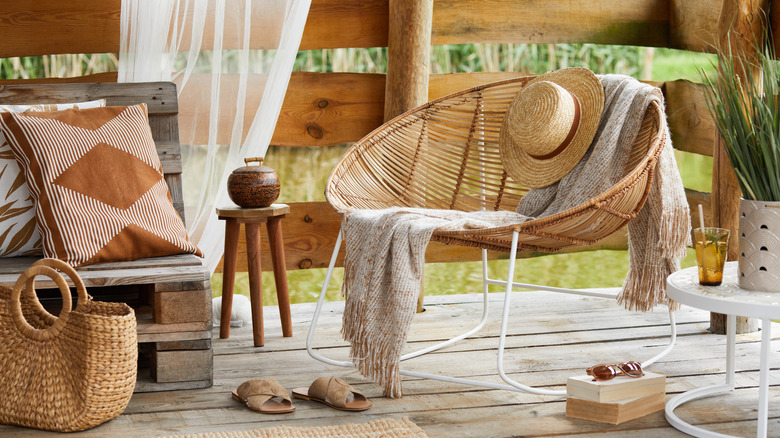Best Ways To Clean Cane And Rattan Furniture
Cane and rattan furniture are timeless pieces that look good with many different designs. They are typically styled with natural elements like plants or florals and wood or jute. They also look good with mid-century furniture and metallic accents. Cane and rattan furniture can be used both inside and outside. Inside the house cane and rattan is often used as lounge chairs, dining sets, and stools.
Outdoors, cane and rattan patio furniture will benefit from a dust sheet that can be placed over them when not in use. This will protect the furniture from dirt and rain, which can cause mold and mildew, explains Abode. Alternatively, you can use synthetic rattan for patio furniture as it's water-resistant and highly durable. Indoors, cane and rattan need to be cared for gently because they are made of natural plant fibers. This makes the furniture susceptible to warping or drying out, depending on the heat and humidity of the home. It also dictates the strength and type of cleanser that should be used.
Soap and water
Paint thinners, abrasive creams, and rough sponges or brushes should never be used to clean cane or rattan. Instead, a soft cloth and mild, diluted furniture cleaner are sufficient. To clean cane and rattan furniture, mix 1 gallon of warm water with 3 tablespoons of soap, according to Networx. If you don't have a mild furniture cleaner, dish soap can be used as well. Wipe the solution all over the furniture, being sure to get in between the weaves of the rattan. A soft bristle toothbrush can be used to get in the grooves.
Be sure not to oversaturate as this can cause the materials to warp. The best way to dry the furniture is to leave it outdoors in the sun. Choosing to clean your furniture on a windy day will also help it to dry quicker. It's also important not to sit in the furniture before it's completely dry, so it can maintain its original shape without any sagging.
Dust with a vacuum or brush
Vacuuming your cane or rattan furniture should also be done to prolong the life of your furniture and prevent you from having to clean it as often. Water isn't good for cane and rattan so vacuuming in between cleanings is a good way to keep it from getting super dirty. You should use a dry brush attachment on your vacuum with medium bristles, explains Networx. Simply run the handheld hose of your vacuum over the furniture, paying attention to the woven panels and crevices.
If you don't have a vacuum or the correct attachment, you can also dust your furniture in other ways. You will need a non-abrasive brush, such as a paint brush, toothbrush, or soft nail brush. All you have to do is brush over the furniture to remove any dust or debris. Dusting should be done at least once a week.
Clean mold and mildew with bleach
Mold and mildew can become a problem with cane and rattan furniture. This is especially true if you don't allow the furniture to dry properly between cleaning, or if they're kept outside without a cover. You'll know if your cane or rattan furniture has mold if you see little black spots that can't be removed with soap and water. Fortunately, mold and mildew can be removed with a relatively easy process.
According to Networx, to clean mold and mildew you will need to mix a solution of 1 cup of bleach and 1 gallon of water. Then using a soft bristle brush, dip into the solution and gently scrub the patches of mold and mildew away. Once they're gone, you will need to thoroughly clean the furniture with clean water. If you don't rise after cleaning with bleach, it can cause permanent damage to the furniture.
Tackle stains
Cane and rattan can stain if you don't wipe slops and spills away immediately. There are a couple of ways to tackle a stubborn stain. First, you can try to clean it with the soap and water mixture and a soft cloth. If that doesn't work you can try adding more soap to the solution and scrubbing harder with a brush, which should be enough to remove even a tough stain.
However, if the stain still cannot be removed there is another method, although it should be used sparingly and only in extreme cases. Using a q-tip, gently work neat bleach into the stain, suggests Abode. Once the stain is gone, again, be sure to rinse the furniture with clean water and dry it with a towel. Cane and rattan are made of natural plant material, so be sure to not leave the bleach on there for too long.
Add moisturizers
Moisturizing cane and rattan furniture is an important step in the cleaning process. Cleaning can dry out the natural plant fibers in cane and rattan. There are several different products that can be used to add moisture back to cane and rattan furniture. Food 52 recommends using an oil or glycerin-based soap like Murphy's oil soap. To apply the soap, it should first be diluted in water and put in a spray bottle. It can be sprayed on the back and undersides of the furniture and wiped down with a cloth. It's important not to spray the top of your furniture or it may leave an oily imprint on your clothes.
Lemon oil is another useful way to clean and moisturize cane and rattan furniture. Lemon oil will not only protect the furniture but will also enhance its shine. It should be applied to a clean cloth and wiped over the furniture.
Clean upholstery
Cane and rattan furniture often has upholstered seat cushions as well. When you are cleaning your furniture you should also clean the cushions. Many are machine washable, but be sure to check the care label before tossing them in the washer (be sure to only put the cover in the wash and not the insert of the cushion.) After a wash cycle, you shouldn't put the seat covers in the dryer. Instead, hang them to air dry. Once they are dry you can put the inserts back in and place the cushions on the furniture.
It is important to be sure that the seat cushion covers and furniture are both dry before putting them back and using them again. Abode explains that if the seat cushions aren't dry, there would be a risk of mold growing in the seat cushion or on the furniture. Additionally, if the cushions are damp, moisture could seep into the rattan, causing it to stretch and become saggy.
Cleaning synthetic rattan
If your outdoor furniture is made from synthetic rattan then it is not as fragile. It can be saturated with water and won't be affected in the same way as the natural plant fibers in cane and rattan furniture. This makes cleaning synthetic rattan a much easier task. Abode recommends turning the synthetic rattan furniture on its side and cleaning it with a garden hose, which will make it easier for the water to run though the weaves.
The same cleaning solution of 1 gallon of warm water to 3 tablespoons of mild soap or dish soap can be used to clean synthetic rattan. After saturating the furniture with the hose, use a firm bristled brush to gently scrub the furniture with the soap and water solution. Rinse it thoroughly with clean water, then allow the furniture to air dry or rub it down with a soft towel.
